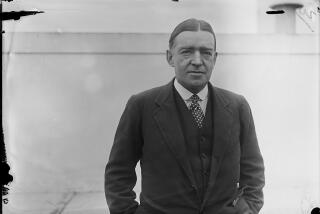Group Hopes to Free Aircraft From Antarctic Tomb : Ice-Locked Plane Focus of Rescue Effort
- Share via
PARIS — A team of more than 50 French and American engineers and technicians is battling the fierce weather of the Antarctic to perform a task worthy of Hercules himself.
They are trying to rescue a U.S. airplane that has been buried under the ice for 15 years.
The plane crashed on takeoff Dec. 4, 1971, while it was on a scientific field trip in Terre Adelie, the French sector of Antarctica. The crew was not injured but had to abandon the craft, and over the years it has been covered by ice and snow.
Only the tail of the 32-foot-high plane is visible from the surface.
The plane is a $35-million LC-130 Hercules, modified with skis to land on ice and snow. Only 12 were ever built.
The U.S. National Science Foundation, which owns it, wants it back.
Expert Crew Recruited
The NSF is paying for the difficult operation and has recruited an expert crew, including an interpreter, from French Polar Expeditions and mobilized a mass of heavy equipment, including half a dozen bulldozers and snowplows.
If the plane is in good condition, the rescuers of the expedition dubbed “321 Rescue” plan to remove the engines, send them to the United States, replace them the next year and have the plane fly home in 1988.
If it is beyond repair, technicians will take the plane apart and bring back some pieces, including three of the four engines, for detailed studies of how the materials survived Antarctic conditions.
If the plane is able to fly again, the science foundation estimates that the whole operation will cost about $10 million.
One of the toughest enemies of the project is the weather, even though the recovery operation is being undertaken in the Southern Hemisphere’s late spring and early summer.
“The wind is the main problem,” said a NSF spokesman. “They can dig through the ice and snow for days and then one night the wind might blow all the snow right back again.”
“It is a long and costly expedition, but worth it for the NSF,” said French Polar Expeditions director Andre Giret. “They want to use this plane for future scientific expeditions in Antarctica.
“It is the only type of (ski-equipped) cargo plane that can make the full trip from New Zealand, which is the closest point to the part of Antarctica they’re studying.”
Two Other Attempts
The LC-130 can transport 19 tons of material a distance of 600 miles and is an adaptation of the Lockheed C-130, a common four-engine turboprop used around the world.
Giret said the NSF had already tried twice to bring back the plane, conducting detailed surveys of its condition.
“The strangest thing is there have been two surveys in the past 15 years, but we don’t have any record of them and the Americans don’t either. They have been lost somewhere,” he said.
Headquarters in both the U.S. and France are making sure that they don’t lose the crew as well in the frozen wastelands of the Antarctic. Giret receives weekly reports from the expedition giving detailed reports on their progress.
The first part of the expedition, a group of 12, set out on Oct. 29 to prepare for the work at the site, 200 miles from the coast and 750 miles from America’s McMurdo Base.
They prepared a landing strip for the invasion of technicians and equipment, which was delivered by plane Nov. 19.
The NSF reported in Washington that three tractors, two American and one French, were being used in early December to excavate the plane. A spokesman said the work was expected to be completed by the end of the month.
Then, sometime in January, a message is to arrive saying whether the plane will be able to fly again.
More to Read
Sign up for Essential California
The most important California stories and recommendations in your inbox every morning.
You may occasionally receive promotional content from the Los Angeles Times.













